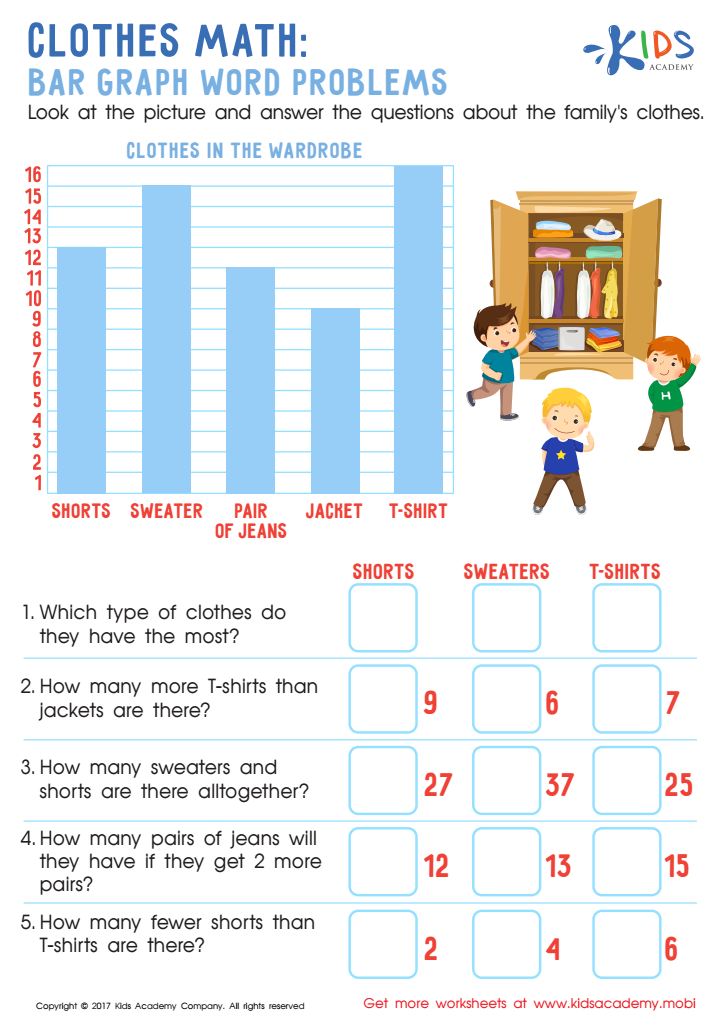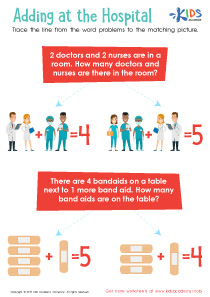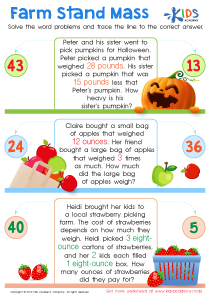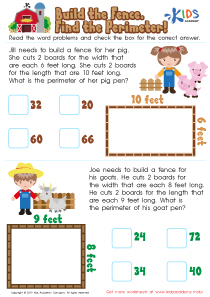Normal Graph Word Problems Worksheets
1 filtered results
-
From - To
Enhance your students' mathematical skills with our Normal Graph Word Problems worksheets, a comprehensive collection designed to challenge and engage learners. Ideal for classroom activities or educational homework sheets, this resource focuses on applying graph-based solutions to real-world scenarios. Each worksheet is meticulously crafted to improve understanding and proficiency in interpreting and plotting data on graphs. Perfect for reinforcing important math concepts, our worksheets ensure a thorough grasp of graph-related problem-solving techniques. Equip your students with the tools they need to excel in mathematics through practical, hands-on learning experiences. Suitable for various educational levels.


Clothes Math: Bar Graph Word Problems Worksheet
Graph word problems are a vital component of mathematical education, offering students a practical and engaging approach to understanding and applying various math concepts. Normal worksheets on graph word problems, such as those often included in school worksheets, play an essential role in this learning process. They not only reinforce classroom learning but also provide a structured way for students to develop their problem-solving skills.
Importance of Normal Worksheets on Graph Word Problems
-
Understanding Real-World Applications: One of the primary advantages of including graph word problems in school worksheets is their ability to help students see the real-world applications of mathematics. Whether it’s understanding trends in data, predicting future outcomes, or analyzing the rate of change, graph word problems equip students with the skills to interpret and make decisions based on numerical data. This relevance to everyday situations makes learning more meaningful and retains students' interest in mathematics.
-
Developing Critical Thinking Skills: Graph word problems require a mix of analytical and critical thinking skills, as students must often decide not only how to solve a problem but also determine what methods to apply. Normal worksheets provide a variety of problems that challenge students to think beyond simple calculations. This fosters a deeper understanding of mathematical concepts and enhances cognitive abilities like reasoning and logic.
-
Enhancing Visualization Skills: Graphs are visual representations of data, and working with them helps enhance students' ability to visualize mathematical concepts and relationships. Normal worksheets on graph word problems encourage students to interpret information presented graphically, which is a crucial skill in many scientific and technical fields. Improved visualization skills can lead to better comprehension of more complex subjects such as calculus and statistics.
-
Encouraging Independent Learning: School worksheets are typically structured in a way that students can work on them independently or with minimal guidance. This encourages self-reliance and helps students develop confidence in their problem-solving capabilities. Graph word problems on worksheets often start with simpler tasks that gradually increase in complexity, providing a scaffolded learning experience that supports independent learning.
-
Providing Assessment and Feedback Opportunities: Teachers can use worksheets to assess students’ progress and understanding of graph word problems and other mathematical concepts. This continual assessment helps identify areas where students may need more support or enrichment. Additionally, feedback can be tailored based on students' performance on these worksheets, making it a valuable tool for personalized learning.
-
Preparation for Standardized Tests: Many standardized tests include graph-based questions. Regular practice with graph word problems through school worksheets prepares students for the types of questions and formats they will encounter on these exams. Mastery of graph interpretation and problem-solving enhances their test-taking strategies and increases their confidence, potentially leading to improved performance on critical assessments.
-
Promoting Collaborative Learning: While worksheets can be used for individual practice, they also provide excellent opportunities for collaborative learning. Students can work together on graph word problems, discussing their approaches and reasoning. This collaboration not only helps students learn from each other but also encourages the development of communication skills as they explain and debate mathematical concepts. Such interactions can deepen understanding and promote a more engaging learning environment.
-
Support for Diverse Learning Styles: Graph word problems on worksheets cater to various learning styles. Visual learners, in particular, benefit from the graphical representation of data, while logical learners thrive on the problem-solving aspect. Having diverse types of questions and problems also ensures that tactile and auditory learners can engage through group activities or teacher explanations linked to the worksheet tasks.
-
Facilitates Progressive Learning: Through the use of normal worksheets, educators can systematically introduce more complex graph word problems as students’ skills advance. This structured approach to progression ensures that all students build a solid foundation before moving on to more challenging problems, minimizing feelings of frustration and supporting continuous learning and improvement.
-
Resource Efficiency: Worksheets are also a resource-efficient way to provide extensive practice in interpreting and solving graph word problems without the need for constant internet access or digital tools. This makes learning accessible to all students, regardless of their technological situation at home, ensuring educational equity.
In conclusion, normal worksheets on graph word problems are more than just paper and pencil tasks; they are a comprehensive educational tool that supports a wide range of learning objectives. From enhancing real-world application skills and critical thinking to preparing for standardized tests and fostering collaborative learning environments, these worksheets form an integral part of math education. Schools that effectively utilize these tools can expect to see notable improvements in their students' mathematical abilities and overall academic performance.
 Assign to My Students
Assign to My Students














